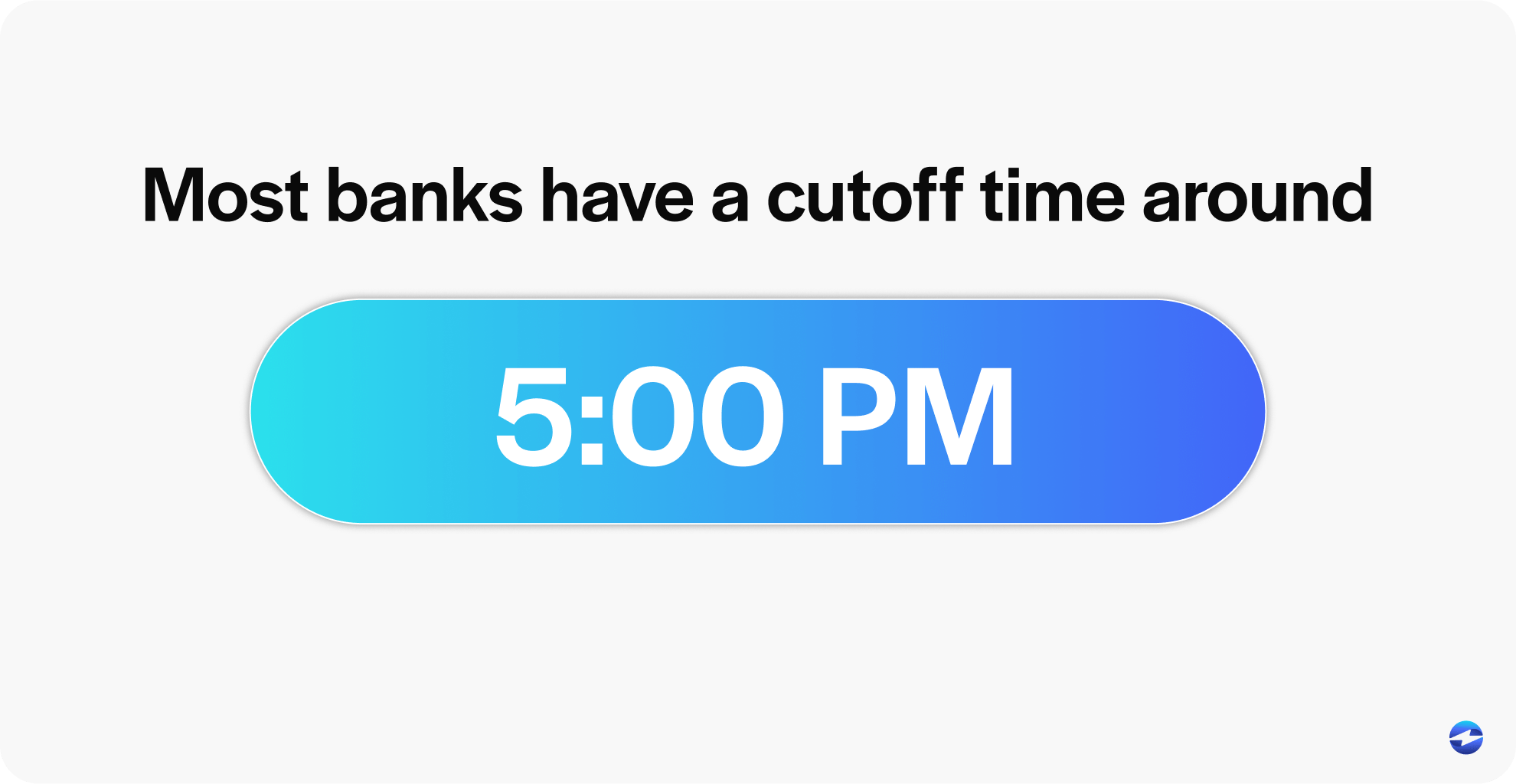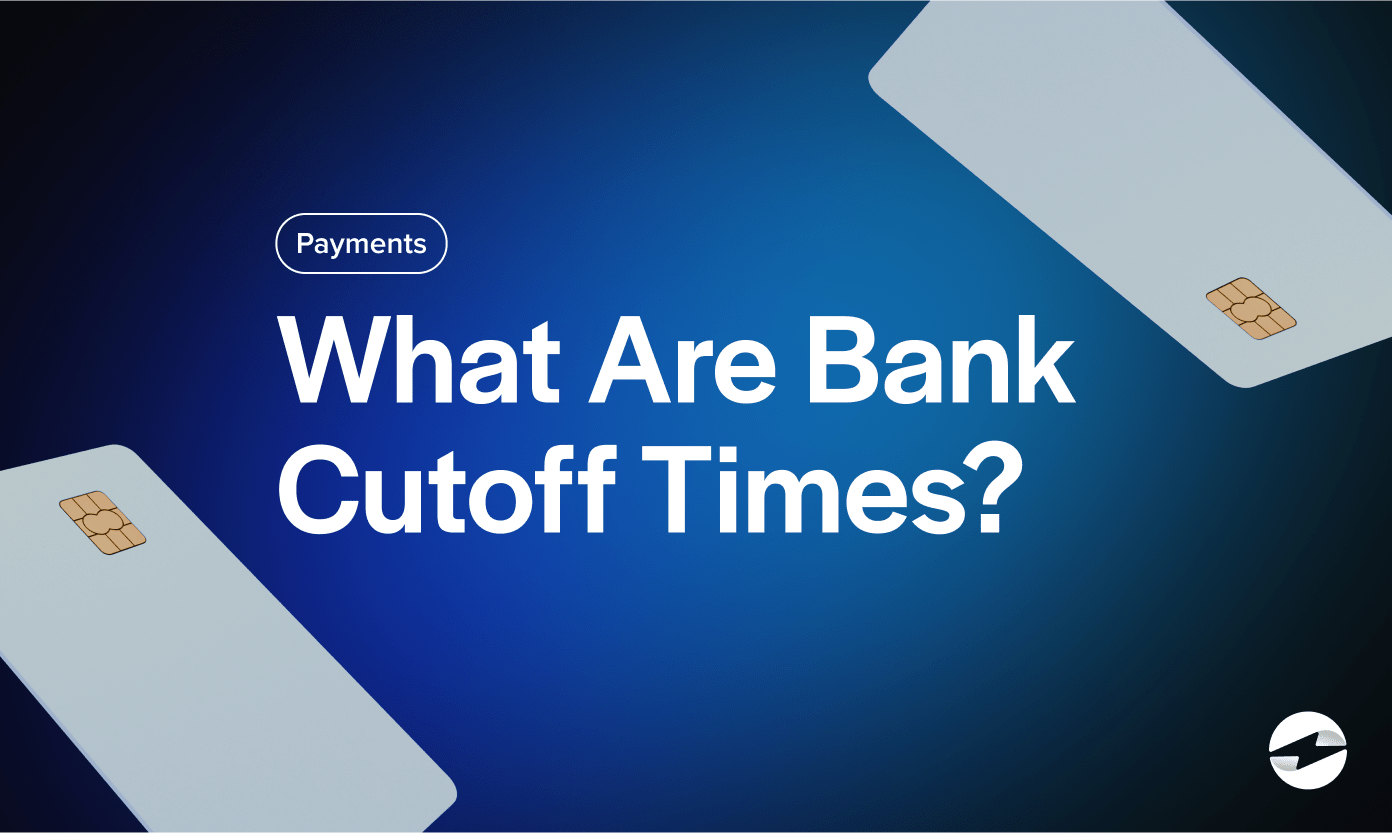Blog > What Are Bank Cutoff Times?
What Are Bank Cutoff Times?
When your business wants to make a check payment, ACH transfer, or process a transaction through its bank, it’s essential to understand bank cutoff times and their implications on the efficiency and timing of your financial operations.
Since these deadlines can drastically alter the pace of transactions, this article provides a clearly explains cutoff times, benefits, and their impact on your business to navigate them effectively.
What are bank cutoffs?
Bank cutoff times refer to specific deadlines set by banks each business day for accepting and processing transactions. Any transactions made after this cutoff time are typically processed on the next business day.
Cutoff times apply to various types of banking transactions, including wire transfers, check deposits, and electronic ACH transfers. These times can vary from bank to bank or depending on the transaction type within the same bank.
Most banks have a cutoff time around 5:00 p.m. local time. It’s important to note that this differs from a bank’s operating hours, which can still be extended past the cutoff time for certain types of transactions.

What is the purpose of bank cutoffs?
Banks use cutoff times to manage and organize their daily financial operations. Setting a specific transaction deadline allows them to efficiently process and reconcile all incoming and outgoing funds within a single business day. This helps avoid errors or discrepancies from processing transactions after the designated time.
Cutoff times also play an important role in fraud prevention. By having a set deadline for transactions, banks can monitor and verify all incoming and outgoing funds within a shorter timeframe, reducing the risk of fraudulent activity.
What is the impact of bank cutoffs on payment delays and holds?
While banking cutoff times may seem like a minor detail, they can have a significant impact on the timing of your financial transactions.
Payment delays and holds on funds are two common impacts of bank cutoffs.
Payment delays
Payment delays occur when transactions are initiated after the bank’s defined cutoff time, forcing them to be processed on the following business day.
For example, if you transfer money to a different bank or pay a bill online and miss the cutoff time, that payment will be processed the following business day.
Payment delays can lead to late payments, extra charges, or cash flow issues, particularly for businesses seeking to pay employees or vendors on time. Therefore, it’s crucial to understand the cutoff times of your bank and factor them into your payment schedule.
Cutoff times may also force banks to hold your funds, impacting overall business operations.

Holds on funds
In addition to payment delays, cutoff times can also affect the availability of funds until the transaction is processed.
For example, if you deposit a check or other funds after the bank’s cutoff, funds will be cleared on the next business day. This means money may appear in your account immediately but it will only be available once the transaction has gone through.
In some cases, banks may also place a hold on your funds for an extended period, typically for large transactions or those involving international transfers. Banks use this security measure to ensure funds are legitimate and have sufficient time to clear before being made available.
5 benefits of bank cutoffs
Banking cutoff times yield many benefits for both banks and businesses that can aid in the efficiency and security of financial transactions.
Five main benefits of cutoff times include:
- Improved efficiency: Cutoff times enable banks to streamline their processing workflow. By enforcing a firm deadline, banks can ensure all transactions are processed within the same working day to improve operational efficiency and consistency in service.
- Fraud prevention: Cutoff times provide banks with a specific window to closely monitor transactions for signs of fraud which can lead to prompt detection and mitigation of suspicious transactions and more payment security.
- Clearer expectations: With precise cutoff times, customers better understand when transactions will be processed. This helps companies and individuals better plan their financial activities to avoid late payments or penalties.
- Resource allocation: Cutoff times assist in resource allocation, especially in businesses. They help organizations manage resources, such as manpower, materials, and equipment, by ensuring they’re available when needed and not wasted through prolonged activities.
- Effective risk management: Cutoff times are a risk management tool employed by banks to strike a balance between customer accessibility and the need to prevent financial risks. By imposing specific timeframes for transaction initiation and clearance, banks can reduce the likelihood of insufficient funds and returned checks.
Thanks to these benefits and others, bank cutoffs help businesses reduce the risk associated with funds while improving efficiency.
Leverage bank cutoffs to generate more financial stability and long-term success
The influence of bank cutoff times reaches far beyond transaction processing. Established timeframes have the potential to significantly impact customer satisfaction and play a pivotal role in defining the competitive position of banks.
By effectively managing risks associated with insufficient funds and returned checks, banks can protect their financial stability and reinforce the reliability and integrity of their services. This encourages customer confidence and compliance with regulatory standards, ultimately contributing to a robust and reputable banking industry.


